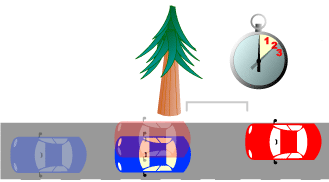
Two-second rule (road)
Encyclopedia

Rule of thumb
A rule of thumb is a principle with broad application that is not intended to be strictly accurate or reliable for every situation. It is an easily learned and easily applied procedure for approximately calculating or recalling some value, or for making some determination...
by which a driver may maintain a safe following distance at any speed. The rule is that a driver should ideally stay at least two seconds behind any vehicle that is directly in front of the driver's vehicle. It is intended for automobiles, although its general principle applies to other types of vehicles.
The two-second rule is useful as it can be applied to any speed. It is equivalent to one vehicle-length for every 8 km/h (5 mph) of the current speed, but drivers can find it difficult to estimate the correct distance from the car in front, let alone to remember the stopping distances that are required for a given speed, or to compute the linear equation on the fly. The two-second rule gets around these problems, and provides a simple and common-sense way of improving road safety.
The practice has been shown to dramatically reduce risk of collision, and also the severity of an accident should an accident occur. It also helps to avoid tailgating
Tailgating
Tailgating is the practice of driving on a road too close to the vehicle in front, at a distance which does not guarantee that stopping to avoid collision is possible...
and road rage
Road rage
Road rage is an aggressive or angry behavior by a driver of an automobile or other motor vehicle. Such behavior might include rude gestures, verbal insults, deliberately driving in an unsafe or threatening manner, or making threats. Road rage can lead to altercations, assaults, and collisions...
for all drivers.
The risk of tailgating is largely caused by the accident avoidance time being much less than the driver reaction time. Driving instructors advocate that drivers always use the "2-second rule" regardless of speed or the type of road. During adverse weather
Weather
Weather is the state of the atmosphere, to the degree that it is hot or cold, wet or dry, calm or stormy, clear or cloudy. Most weather phenomena occur in the troposphere, just below the stratosphere. Weather refers, generally, to day-to-day temperature and precipitation activity, whereas climate...
or hazardous conditions, it is important to maintain an even greater distance of three or four seconds behind the vehicle in front of you.
It tells a defensive driver
Defensive driving
The standard Safe Practices for Motor Vehicle Operations, ANSI/ASSE Z15.1, defines defensive driving as "driving to save lives, time, and money, in spite of the conditions around you and the actions of others." This definition is taken from the National Safety Council's Defensive Driving Course...
the minimum distance needed to reduce the risk of collision under ideal driving conditions. The allotted two-seconds is a safety buffer, to allow the following driver time to respond.
To estimate the time, a driver can wait until the rear end of the vehicle in front passes any distinct and fixed point on the roadway - e.g. a road sign, mailbox, line/crack/patch in the road. However, don't take your eyes off the vehicle for more than a second or that would defeat the purpose. As you count to yourself the elapsed time in seconds, the front of your car should pass the same point no less than two seconds later. If the elapsed time is less than this, increase the distance, then repeat the method again until the time is at least 2 seconds.
One can count the duration of time simply by saying "one... two..." but for greater accuracy, it is suggested that drivers say "only a fool breaks the two-second rule". At a normal speaking rate, this sentence takes approximately two seconds to say, and serves as a reminder to the driver of the importance of the rule itself.
The TailGuardian distance advisory decals recently adopted by Stagecoach Buses
Stagecoach Group
Stagecoach Group plc is an international transport group operating buses, trains, trams, express coaches and ferries. The group was founded in 1980 by the current chairman, Sir Brian Souter, his sister, Ann Gloag, and her former husband Robin...
in the UK use the two second rule in their calibration. Advisory Decals for 30, 50 and 70 mph are calibrated to be invisible outside those safe distance, only rendering themselves visible once the car following has entered the safety zone for the speed that they are travelling
External links
- Tutorial: Keep Your Distance - Traveling Safely behind other traffic - by Driving School Ireland
- Illinois "Rules of the Road" - See Chapter 11 Safe Driving Tips for details on the "three-second rule"
- How to practice following distance rules
- Passive advisory decals to following traffic

